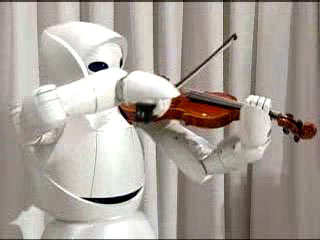 | |||||||
|
robot violin the seduction of the machine
Dr. J. Rosenberg, peering into the future, suggested in 1953 that "Our experimental rabbit is caught in the glare of the headlights and dazzled by the machine. He cannot look away in time to save his transitory existence" As a colleague wrote me on hearing of Toyota's computer driven violin concert - the end is nigh! Well not really as the resulting piece of Elgar (what a non-choice for violin music) is actually no improvement on the Violano - an automatic violin playing machine of 100 years ago. In fact it could be a retrograde step, as the facility of the Violano - including it's ability to play counterpoint on the four standard violin strings at the same time, its variety of bow strokes, and its sheer speed, its rich vibrato when required, leaves the Toyota sitting on the start line. But the suits at Toyota have other issues to attend to as the audience watch open mouthed when the robot plays a rhythmically inept version of The Pomp and Circumstance March. The notion of a humanoid playing the violin could be assessed as thinking well 'within the box' or brain of the spotty teenager. The Violano team already went beyond that by incorporating a wheeling-bow for each string and eleven fingers for the G,D, and A strings, with an impressive twentyone fingers on the E string. By contrast the Toyota humanoid trumpet player seems to have more success - trumpets require less finger and arm co-ordination and anyway, they made a special embrasure and mouth piece to get an acceptable sound. The question remains however, why bother? Is there any ameliorating justification for such expensive brand advertising? Not really, except I'll add it to the already overfull cabinet of cringing violin iconography in the Rosenberg Museum. Ever since the beginning of music, audiences have wanted more bang for their buck. The staging of music in reverberant caves such as Lascaux was as much to do with sonic enhancement as it was to keep the stone age participants from getting their head bitten off by a carnivorous passer by. Stockhausen returned to the cave in the 1970s for some of his electronic happenings declaring atmospheric spook factor but really it was for the reverb which could not be faked. In between the Greeks pondered if nature itself could take over all the physical effort required with the invention of the Hydraulis - the water powered organ. The seduction of novelty automata (notably, organs, bells, hurdy-gurdy, various manifestations of the one man band) aided by water and the wheel continued to the Industrial revolution. And then it became a preoccupation of the ruling elite to get rid of the worker-musician. As for the musician - an easier work load crept into view. And then the electric guitar spun its web - a short circuit to power and celebrity for the often technically challenged. The Mephistophelesian exchange of what is real and what is fake continues to excite the species - it positively enthuses your average French cultural theorist. Ever since I put my violin into the ring with the Fairlight CMI sampler in 1983 for The Tango Project with Martin Wesley-Smith, I also confess to the challenge of the quick and the dead. The violin and its simulacra have been a stimulating conflict without resolution since that time. I enjoy spotting the differences that sound when the two processes collide. The simulated (what used to be known as the virtual) highlights what makes the imperfect reality of violin technique and sound so beautiful. If you play the violin for the life long haptic relationship, then you cannot be replaced. But if you play the violin to please the Toyota people of this world, then your replacement by a robot becomes a matter of economics and time - which is evidently not on your side. |
 |
